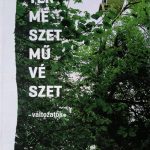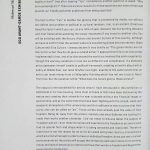Nature Art-Variations (Catalogue) | MUSARNOK | Eco-Avant-Garde | Mahmoud Maktabi | P 206-215 | October 2016
After every exhibition opening or lecture or a friendly talking, the first early common question comes out from friends and artists of different countries is that “Can you work legally in Iran?” And after hearing “Yes”, immediately another question is asked: “Why Environmental Art?” There are various reasons for these questions but none of them will prevent our friends and other audiences from being surprised.
The fact is that “Iran” is neither too gloomy that is presented by media, nor without any defect and problem or political or cultural tensions. Iran, is an ancient, broad and beautiful land in which you can, at any time of year, discover the hot burning desserts and, feel freeze while watching the snowy mountains if you travel to another city; You will be satisfied with the Nature, History and ancient Culture of this country, although we have to confirm that this ancient culture is now distinguished into two section: State Culture and Elite Culture. I always declare it very briefly as “The governments are not barrier for us but they do not give us a hand either.” I approve that this is not exclusively implemented in Iran, and all artists around the world are involved the same experience, though the working conditions in Iran are so different and complicated. If a domestic artist dedicates himself totally to political framework, creating artworks about war or policy of Middle East, can fame him/her overnight, exactly to the same extent that an artist can make money from a Calligraphy-Painting which has not any trace or flavor from Iran. But the question is that “What does the nature give to these artists?”
The nature is the battlefield for artists whom I have introduced in this exhibition, a battlefield in its true meaning, since most of these artists have been discovering the nature and creating their artworks for near a decade without any financial target or sponsorship, and at the same time they have been fighting with the closed, silent and academic atmosphere of the universities and its traditional artists to prove that their works also can be called as “art”. These artists have already paid the value of their freedom. Being far away from the artistic markets and what Galleries are looking for, made their works another character. I did not mean to discuss about the subject of “freedom and art”, but I think the human will experience the freedom in art and art will find its special form and shape when it is being censored and restricted. Therefore restriction is not the reason for an art to be raised and grown, but is a circumstance which an artist will accept in order to have an individual freedom. As we can see in Iranian environmental art the artists will accept the limitations and restrictions of not earning money and lack of attention in order to continue their works in freedom and beyond the governmental monitoring.
Nevertheless, this moving towards the nature does not necessarily mean an objection to the restrictions or galleries or museums. This action is much more formed based on Iranian mythic and philosophic approach, the same you can see in South Korea in which the source of most of the nature artworks are the thought that Korean traditional painters worked based on.
Iranians are so dependent to their old culture and world view, the thought and culture which is inherited to the Iranian people especially from their past literature and poetry. The tombs of Iranian classic poets and philosophers are still one of the most visited places, while as the last famous classic poet of Iran died about 7 centuries ago. Therefore it is obviously so difficult to bring a new art and a new thought into a country with this much of loyalty to tradition and mythic thoughts. But this loyalty and dependency to traditions is also an advantage: there is always a background and basis for a frim and stable identity. This basis and stable identity itself, which is resulted by Iran old thought and history, will highlight Iranian artists with features which are exclusively belonged to them and diverse from others’. Actually, the Iranian environmental artists, as the pioneer artists, have begun a hip-and-thigh war to enter a new and free thought and idea. They were welcome in society after they succeeded to prove their art and idea, because they are acting as a bridge between the past and today.
The best example of Iranian artists is Ahmad Nadalian who is known as pioneer of environmental art in Iran. He uses the elementary and incipient instruments for his creations and mainly applies the techniques such as lithography and stamps for printing which was used by people thousand years ago for creating their desired pictures. You can watch and enjoy the old samples of lithography and stamps by visiting the Museum of contemporary arts in Tehran. But this artist also is a pioneer in digital and internet-based art in Iran, using the virtual and social networks at most, to show the pictures and videos of his artworks. With all mentioned, perhaps the most important aspect of Ahmad Nadalian’s works is the very “Lost Heaven” which has been transfigured from the Iranian myths and thoughts in his artworks. He lithographed some kinds of fish in rivers which are not alive nowadays, the rivers are now dried up or totally disappeared because of the numerous dams and unlimited consumptions of water and sources and natural energies implemented by governments. These events make the artists to pay attention to a new anxiety named “environmental protection” together with involvement with re-construction of old thoughts, and proceed with re-interpretation of mankind and nature relationship. So our mentioned nature is not a dramatic and virgin one whom being as a refuge for the artists to make decorative or romantic work in it, but its wide will cover the cities and ecocline.
Iranian artists deal the ecological issues as other artists in the world, so they face too many ecological problems such as dries of lakes and swamps, extinction of local animals, cities pollution, ignorance to consistent development and etc. These problems are usually caused by government inattention, overconsumption of natural resources, changing the ecosystem and etc. These issues are serious concerns of artists which sometimes they mix with social and political attitudes.
Nevertheless in most of cases these artworks could not do anything for these issues and they usually just act as an alarm buzz which reminds us the problems, so there is a huge difference between them and ecological art specially the American version. The probable question is that is it the weak point of these artworks or a special feature of that?
“Reqiuem of the zaindehrood’s birds” by Nooshin Nafisi is a good example in which the concern for environment, city, myth and nature have been attached to each other. Also “Destruction of Nature, Destruction of Human-Being” by Raheleh Zomorodinia, “The spirit of tree” by Freshteh Alamshah have concerns about the relation between human and nature and their future challenges. The deep relation of Tara Goodarzy with nature, invite us to go to nature and discover nature again and finally works by Karim Allahkhani And Farzaneh Najafi are trying to find the roots in the nature as well as works by Ahmad Nadalian, Mahmoud Maktabi and Atefeh Khas that have the same approach. Some other works had special position in this exhibition despite their difference in the medium such as painting and installation by Ane Mohhamad Tatari However the material were not gained from nature directly but our concerns and our artistic worlds are the same. Generally all the artworks in this exhibition are the artist’s attempt for showing beauty. All of them are presenting a fine image even if they are talking about death and termination, because these artists are searching for the “other world” not “the clear topic” as well as their ascendants. The other world is the lost heaven that is being searched by the artists and philosophers and there is no guilt and dirt in it and this is a base in Iranian art and philosophy. Nature is giving an inspiration which can’t be find easily in the galleries and studios.
It was a short review on the works of Iranian environmental artists who always have to main concerns. The first one is to create a new movement in Iranian contemporary art and join the global movements of art and nature. The second one is to have unique style for themselves as the Iranian artist, the artist who feces the adorable background on his history and culture in one hand and the modern concern in the other hand. It is quite clear that artists experience this process all around the world but Iranian special feature is their attachment to the ancient patterns and beliefs. So as we saw this feature can bold their artworks but the problem is that their artworks have not any effect on the issues such as nature decay and etc., and they just remind us some problem.
However in developing countries usually no one seriously takes care about nature and ecology and it’s not a challenge only for artists so these kinds of artworks can be a start to build a new culture. The cycle of life and death in nature, art and thinking and the artworks sometimes remind us the forgotten stories to live again in a new way and express new ideas that will replace with the old beliefs and patterns.


